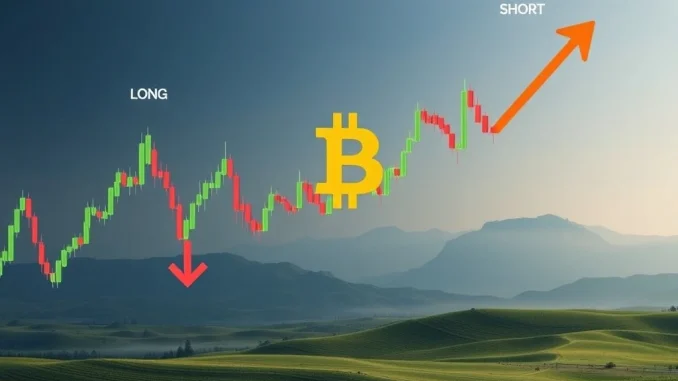
In the dynamic world of cryptocurrency trading, understanding market sentiment is crucial. One powerful tool traders use to gauge this sentiment, particularly for Bitcoin, is the BTC long short ratio on perpetual futures markets. This ratio provides a snapshot of whether more traders are betting on price increases (going ‘long’) or decreases (going ‘short’) at a given time.
Understanding the BTC Long Short Ratio: What Does It Tell Us?
The long-short ratio for Bitcoin futures is a simple yet insightful metric. It compares the total volume or number of long positions to the total volume or number of short positions open on an exchange or across multiple exchanges. A ratio above 1 (or more than 50% long) suggests a generally bullish sentiment, while a ratio below 1 (or more than 50% short) points towards a more bearish outlook.
Why is this data important? Perpetual futures markets are highly active and leveraged, making them sensitive indicators of short-term market mood. Monitoring this ratio helps traders:
- Gauge overall market bias.
- Identify potential shifts in sentiment.
- Compare sentiment across different exchanges.
Recent Bitcoin Futures Data: A Snapshot of Sentiment
Looking at the latest trading data for BTC perpetual futures over the past 24 hours provides a clear picture of current positioning. Across major exchanges, the aggregate data shows a slight lean towards short positions.
Here are the recent 24-hour long-short ratios:
- Total Market: Long 49.03%, Short 50.97%
Examining top individual exchanges reveals similar trends, though with minor variations:
- Binance: Long 48.38%, Short 51.62%
- Bybit: Long 49.37%, Short 50.63%
- Gate.io: Long 47.76%, Short 52.24%
This data indicates that, collectively, slightly more capital was positioned on the short side in Bitcoin perpetual futures over this period.
Analyzing Crypto Sentiment: What the Ratios Imply
The fact that the total ratio is just under 50% for long positions suggests a marginally bearish or cautious sentiment among traders in the perpetual futures market over the last day. While not a strong directional signal, it shows that short sellers held a slight edge in positioning.
Differences between exchanges can also be interesting. Gate.io, for instance, showed a higher percentage of short positions compared to Binance and Bybit, potentially indicating localized sentiment or different trading strategies among its user base.
It’s important to remember that the long-short ratio is just one indicator. It doesn’t predict future price movements with certainty but offers valuable context about how traders are currently positioned.
Leveraging Trading Data: How Traders Use Long-Short Ratios
Experienced traders often use the BTC long short ratio in conjunction with other tools. Here are a few ways this data can be leveraged:
- Confirmation: If the price is falling and the long-short ratio shows a significant increase in short positions, it can confirm the bearish trend sentiment.
- Contrarian Signals: Sometimes, an extreme skew in the ratio (e.g., overwhelmingly long) can be seen as a potential contrarian signal, suggesting a possible squeeze if the market moves against the majority.
- Risk Management: Understanding the prevailing sentiment helps traders assess the potential for sudden volatility if positions are heavily skewed in one direction.
Using this data requires nuance. A slightly higher percentage of shorts, as seen in the recent data, might reflect short-term hedging, profit-taking, or a cautious market stance rather than a strong conviction for a large price drop.
The Role of Perpetual Futures in Market Analysis
Perpetual futures are a popular instrument in crypto trading because they allow traders to speculate on price movements without an expiry date, using leverage. This makes their trading data, like the long-short ratio, a key barometer for active trader positioning and short-term market expectations. Analyzing this data provides insight into the leverage being used and the directional bets being placed by a significant segment of the market.
Conclusion: Staying Informed with Key Data
Monitoring the BTC long short ratio and other Bitcoin futures data is a fundamental practice for anyone serious about navigating the crypto markets. The recent data showing a slight dominance of short positions in perpetual futures highlights a cautious or slightly bearish sentiment among traders over the past 24 hours. While this single metric doesn’t tell the whole story, integrating it into your analysis alongside price action, volume, and other indicators can provide a more complete picture of the market landscape and help inform your trading decisions.



